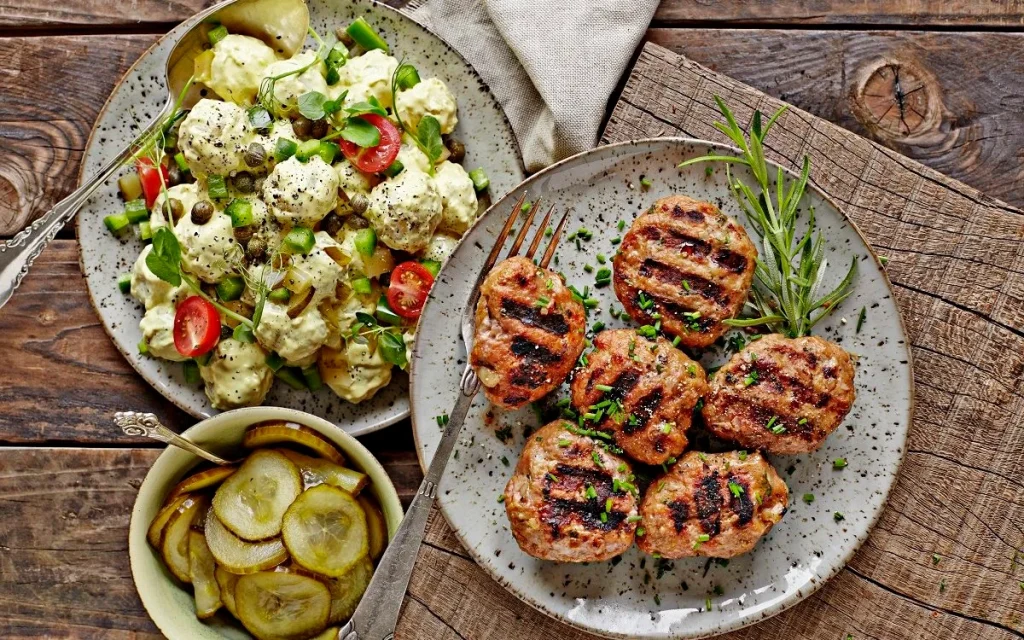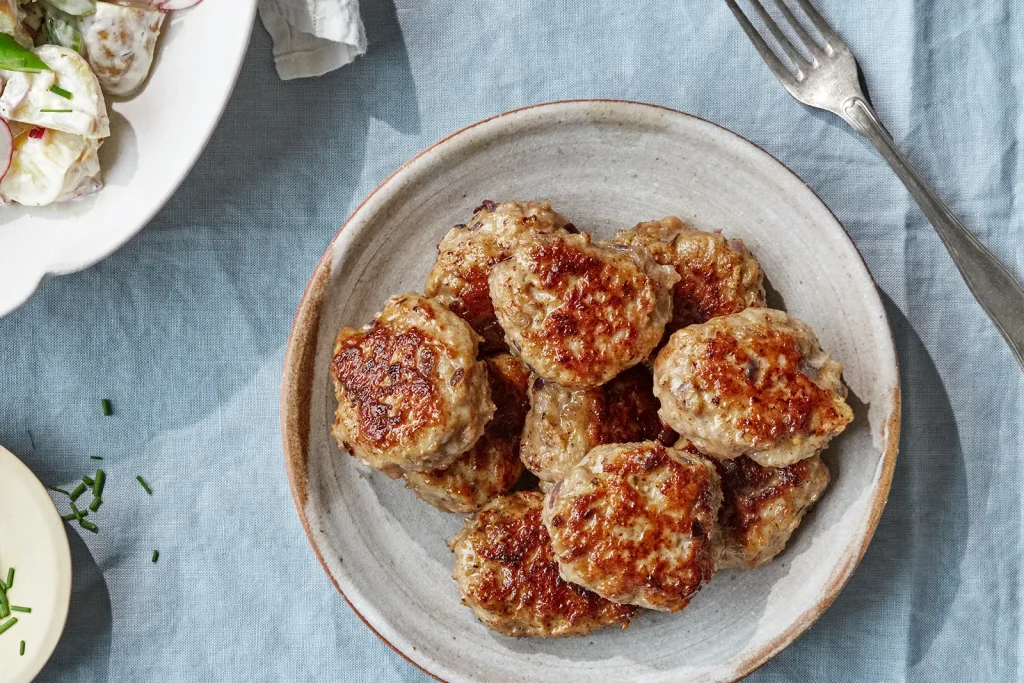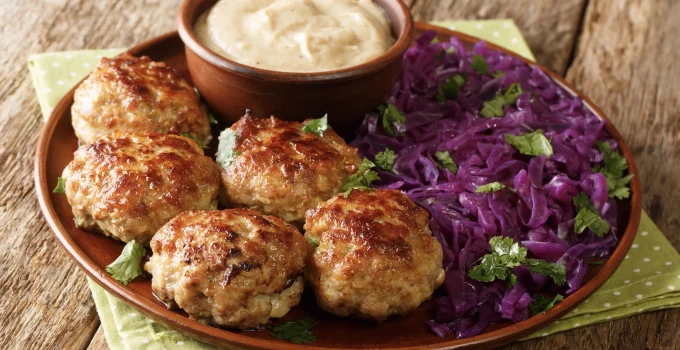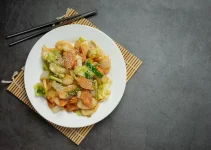Frikadeller has a complex history and bright future. Denmark’s meatball is a woven tapestry of tradition that peppers culture through every tender bite. Frikadeller is more than just a dish; it is a relic of artistic singularity passed down through time as a family tradition. It was born out of necessity during hard times when meat needed to be stretched. It has since become an honored staple, plated up and served in homes all over Denmark.
The preparation of Frikadeller is a generational collaboration. Every family has its own variation, nuanced over time to create the ultimate flavor experience. The sheer filler content makes the flavor work; the meat itself is a celebration of the modest lifestyle and brilliant satisfaction. The meal’s hands-on aspect has woven it into the fabric of Danish family life. Over the years, it has kept Danish families together and happy. Frikadeller is deeply woven into Danish life; it illustrates what life and living are for most people living away from home. Other than that, Frikadeller performs a noble work as a culinary ambassador.
With every bite substantial and savory meat, Frikadeller introduces Danish cuisine to the world. Its status as food cherished by both the locals and foreigners makes it a “ soft export.” It will live on. Frikadeller is more than a meal; it is an intricate part of Danish culture.

Ingredients and Preparation of Frikadeller
The magic of Frikadeller lies in its simplicity and the quality of its ingredients. Ground pork, or a mix of pork and beef, provides the foundation, offering a rich, fatty base that ensures juiciness and flavor. Finely chopped onions add a hint of sweetness and texture, while breadcrumbs and an egg bind the mixture together, allowing it to hold its shape during cooking.
Seasoning is key; a blend of salt, pepper, nutmeg, and allspice brings warmth and depth, enhancing the meat’s natural flavors. Some recipes also incorporate milk or sparkling water, which lightens the texture, making the meatballs delightfully tender and moist. The art of making Frikadeller is in balancing these elements to achieve the perfect consistency and taste.
The preparation process is straightforward yet requires a certain finesse. The meat mixture is shaped into oval patties, which are then pan-fried until golden brown on the outside and succulent on the inside. Mastery comes from knowing just when to flip them to achieve the ideal crust while preserving their tender interior. It’s this deceptively simple technique that turns basic ingredients into culinary gold.
Traditional Accompaniments and Serving Suggestions
In Denmark, Frikadeller is typically served with an assortment of sides that enhance its robust, umami flavor profile. They are frequently consumed with elitist potatoes coated in a silky parsley sauce to provide a velvety, velvety balance to the meatballs. Tangy, crisp pickled red cabbage contrasts well with the mixture, and creamy cucumber salad works to offer a cool crunch. This harmony of textures and aromas is a triumph of classical Danish staples.
Frikadeller’s flexibility also lends itself to a variety of applications. It can be eaten with a variety of gravies, placed on a bed of rich mashed potatoes, or even served cold on a smørrebrød, a classic Danish open-faced sandwich, attesting to its adaptability. This demonstrates Frikadeller’s timelessness and broad appeal. Furthermore, during the festivities, Frikadeller is traditionally the star of the plate, surrounded by various classic Danish dishes.
This highlights both the meatballs’ flexibility and the Banans’ impact on national Danish flair. This wondrous recipe is matched by the pleasure of sharing a meal of Frikadeller with loved ones, demonstrating the Danish tradition of hygge in practice.
Variations of Frikadeller Across Different Regions of Denmark
Though the basic components of Frikadeller remain constant, regional variations abound, each adding a unique twist to the classic recipe. In some parts of Denmark, fish replaces meat, resulting in fiskefrikadeller, a lighter version that’s favored in coastal areas. Here, the delicate flavor of cod or haddock is enhanced with fresh dill and lemon, offering a seafood take on the traditional meatball.
Other variations include the inclusion of grated vegetables, such as carrots or zucchini, to add moisture and nutrition. Some regions incorporate local herbs and spices, reflecting the area’s specific culinary preferences and traditions. These subtle differences not only highlight the versatility of Frikadeller but also the diversity within Danish cuisine itself.
The exploration of regional variations is a culinary adventure, showcasing how a simple dish can be adapted to suit different tastes and ingredients. It’s a testament to the creativity and innovation inherent in Danish cooking, proving that even the most traditional dishes can be reinvented and refreshed.
Tips for Making Perfect Frikadeller at Home
Making Frikadeller at home is an achievable feat, promising a rewarding and delicious outcome. The key to success lies in the quality of ingredients and the care taken during preparation. Opt for high-quality, fatty meat for juiciness, and don’t skimp on the seasoning – it’s what elevates the flavor.
Mixing the ingredients by hand allows for a more tender meatball, as it prevents overworking the mixture, which can result in toughness. Chilling the mixture before forming the meatballs can also make the shaping easier and improve the texture.
When frying, use a blend of butter and oil for the best flavor and browning. Don’t overcrowd the pan – give the meatballs room to cook and turn them gently to ensure a crisp, even crust. Remember, practice makes perfect, and even the less-than-perfect attempts will be a delicious part of the learning curve.

Popular Restaurants and Eateries Serving Frikadeller in Denmark
For those seeking to experience authentic Frikadeller without venturing into the kitchen, Denmark boasts numerous eateries renowned for their rendition of this classic dish. From cozy cafes in the heart of Copenhagen to quaint country inns, the quest for the perfect Frikadeller is a delicious journey through Danish culture and cuisine.
In Copenhagen, traditional Danish restaurants, or “smørrebrød” shops, offer Frikadeller as a staple, showcasing their pride in this national dish. Beyond the capital, local diners and family-run establishments serve up hearty portions, often accompanied by stories of the recipe’s heritage and significance.
Exploring these eateries not only satisfies the palate but also offers insight into the Danish way of life, where food is an expression of history, community, and conviviality. Each bite of Frikadeller savored in these settings is a taste of Denmark’s culinary soul.
Health Benefits and Nutritional Value of Frikadeller
Although rather simple, Frikadeller represents a worthy source of essential nourishment. The lean meat presents high-quality protein vital for the growth and renewal of tissues while onions and spices add an extra serving of antioxidants and vitamins. Nevertheless, to bring the dish in line with the principles of health-promoting nutrition, one would need to make a few adjustments. For example, leaner parts of meat or substitute options like turkey or chicken pass as preferable.
The dish would become lighter and less damaging to one’s heart health due to a lower fat content. Grated vegetables would introduce more fiber, which is beneficial for digestion and the absorption of nutrients. With the balance of ingredients held within the adequate proportions and consumed reasonably often, Frikadeller may rightfully be placed on the list of adequate and nutritious meal options. The variety of healthier alternatives suitable for the preparation of various keeps the dish relevant in contemporary wellness-oriented cooking scenarios.
Frikadeller in Danish Cuisine – A Comparison with Other Meatball Dishes
While Frikadeller holds a special place in Danish hearts, it’s interesting to note its position within the broader spectrum of meatball dishes worldwide. Unlike Italian meatballs, which are often served in a tomato-based sauce, or Swedish köttbullar, accompanied by lingonberry jam and gravy, Frikadeller stands out for its simplicity and the distinct flavor profile conferred by spices like nutmeg and allspice.
This comparison highlights the cultural nuances that shape culinary traditions, demonstrating how a humble dish like meatballs can vary significantly from one country to another. It underscores the rich diversity of global cuisines and the universal appeal of comfort food, of which Frikadeller is a prime example.
The exploration of these differences is not only a gastronomic adventure but also a journey through the world’s cultures, traditions, and histories. It reaffirms the idea that food is a powerful medium for connection, understanding, and appreciation of jp slot.
Final Thoughts on Frikadeller
Frikadeller embodies the essence of Danish cuisine: simplicity, quality, and comfort. This beloved meatball transcends its humble origins to represent a piece of Denmark’s cultural heritage, cherished by generations. Whether enjoyed in a Danish home, a bustling street in Copenhagen, or anywhere around the world, Frikadeller invites us to partake in a culinary tradition that is both deeply personal and universally appealing.
The journey through the history, preparation, and enjoyment of Frikadeller reveals much about the Danish spirit – pragmatic yet passionate, with a profound appreciation for the joys of good food and good company. As we savor each bite, we’re reminded of the power of simple ingredients to bring people together, creating moments of comfort, celebration, and connection.
In the end, Frikadeller is more than just a dish; it’s a celebration of Danish culinary craftsmanship, a symbol of national pride, and a testament to the enduring allure of comfort food. So, here’s to Frikadeller – a small meatball with a big heart, inviting everyone to dive into the juicy, savory delights of Denmark’s favorite comfort food.
This exploration offers a taste of the rich narrative behind Denmark’s cherished Frikadeller, highlighting its cultural significance, culinary versatility, and enduring appeal. Though concise, this overview encapsulates the essence of a dish that is much more than the sum of its parts, inviting readers to discover the warmth and conviviality of Danish cuisine through its most iconic meatball.
Also read: Unleash the Beast: C63 AMG – Power, Performance, and Prestige Redefined




